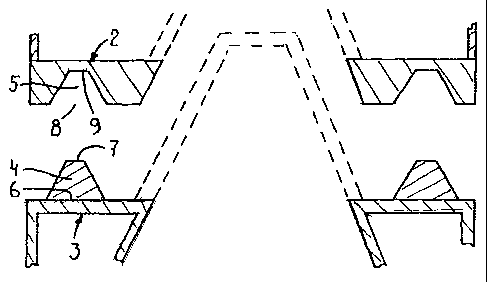Some of the information on this Web page has been provided by external sources. The Government of Canada is not responsible for the accuracy, reliability or currency of the information supplied by external sources. Users wishing to rely upon this information should consult directly with the source of the information. Content provided by external sources is not subject to official languages, privacy and accessibility requirements.
Any discrepancies in the text and image of the Claims and Abstract are due to differing posting times. Text of the Claims and Abstract are posted:
| (12) Patent: | (11) CA 2693573 |
|---|---|
| (54) English Title: | ASSEMBLY OF TURRET AND DISCONNECTABLE BUOY |
| (54) French Title: | ENSEMBLE DE TOURELLE ET DE BOUEE DECONNECTABLE |
| Status: | Granted and Issued |
| (51) International Patent Classification (IPC): |
|
|---|---|
| (72) Inventors : |
|
| (73) Owners : |
|
| (71) Applicants : |
|
| (74) Agent: | BLAKE, CASSELS & GRAYDON LLP |
| (74) Associate agent: | |
| (45) Issued: | 2014-01-07 |
| (86) PCT Filing Date: | 2007-07-16 |
| (87) Open to Public Inspection: | 2009-01-22 |
| Examination requested: | 2012-06-19 |
| Availability of licence: | N/A |
| Dedicated to the Public: | N/A |
| (25) Language of filing: | English |
| Patent Cooperation Treaty (PCT): | Yes |
|---|---|
| (86) PCT Filing Number: | PCT/EP2007/057319 |
| (87) International Publication Number: | EP2007057319 |
| (85) National Entry: | 2010-01-14 |
| (30) Application Priority Data: | None |
|---|
Assembly of turret and disconnectable buoy, in which the turret at its lower
end
and the buoy at its upper end are provided with mating coupling provisions.
The coupling
provisions comprise an annular projection protruding from one of the turret
and buoy towards the
other of the turret and buoy and a correspondingly shaped annular recess on
the other of the
turret and buoy for receiving the annular projection. The annular projection
has a base which is
wider than a top thereof, whereas the annular recess has a top which is wider
than a base
thereof.
L'invention concerne un ensemble de tourelle (2) et de bouée déconnectable (3). L'extrémité inférieure la tourelle et l'extrémité supérieure la bouée comportent des éléments d'accouplement correspondants. Les éléments d'accouplement comprennent une saillie annulaire (4) faisant saillie soit de la tourelle soit de la bouée en direction soit de la bouée soit la tourelle ; une cavité annulaire de forme correspondante (5) sur soit la bouée soit la tourelle pour recevoir la saillie annulaire. La saillie annulaire est munie d'une base (6) qui est plus large que sa partie supérieure (7) ; la cavité annulaire est munie d'une partie supérieure (8) plus large que sa base (9).
Note: Claims are shown in the official language in which they were submitted.
Note: Descriptions are shown in the official language in which they were submitted.

2024-08-01:As part of the Next Generation Patents (NGP) transition, the Canadian Patents Database (CPD) now contains a more detailed Event History, which replicates the Event Log of our new back-office solution.
Please note that "Inactive:" events refers to events no longer in use in our new back-office solution.
For a clearer understanding of the status of the application/patent presented on this page, the site Disclaimer , as well as the definitions for Patent , Event History , Maintenance Fee and Payment History should be consulted.
| Description | Date |
|---|---|
| Change of Address or Method of Correspondence Request Received | 2020-10-23 |
| Inactive: Associate patent agent added | 2020-04-29 |
| Appointment of Agent Request | 2020-03-17 |
| Revocation of Agent Requirements Determined Compliant | 2020-03-17 |
| Appointment of Agent Requirements Determined Compliant | 2020-03-17 |
| Revocation of Agent Request | 2020-03-17 |
| Common Representative Appointed | 2019-10-30 |
| Common Representative Appointed | 2019-10-30 |
| Grant by Issuance | 2014-01-07 |
| Inactive: Cover page published | 2014-01-06 |
| Pre-grant | 2013-10-08 |
| Inactive: Final fee received | 2013-10-08 |
| Notice of Allowance is Issued | 2013-08-30 |
| Notice of Allowance is Issued | 2013-08-30 |
| Letter Sent | 2013-08-30 |
| Inactive: Approved for allowance (AFA) | 2013-08-26 |
| Letter Sent | 2012-07-05 |
| Request for Examination Requirements Determined Compliant | 2012-06-19 |
| All Requirements for Examination Determined Compliant | 2012-06-19 |
| Request for Examination Received | 2012-06-19 |
| Letter Sent | 2011-06-02 |
| Inactive: Single transfer | 2011-05-13 |
| Inactive: Cover page published | 2010-03-31 |
| Inactive: Notice - National entry - No RFE | 2010-03-18 |
| Application Received - PCT | 2010-03-16 |
| Inactive: IPC assigned | 2010-03-16 |
| Inactive: First IPC assigned | 2010-03-16 |
| National Entry Requirements Determined Compliant | 2010-01-14 |
| Application Published (Open to Public Inspection) | 2009-01-22 |
There is no abandonment history.
The last payment was received on 2013-06-19
Note : If the full payment has not been received on or before the date indicated, a further fee may be required which may be one of the following
Patent fees are adjusted on the 1st of January every year. The amounts above are the current amounts if received by December 31 of the current year.
Please refer to the CIPO
Patent Fees
web page to see all current fee amounts.
Note: Records showing the ownership history in alphabetical order.
| Current Owners on Record |
|---|
| BLUEWATER ENERGY SERVICES B.V. |
| Past Owners on Record |
|---|
| JACOB DE BAAN |